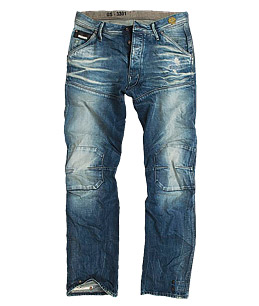
There's a rumor that an accountant employed by G-Star, which is headquartered across several low-rise buildings on an industrial estate southeast of Amsterdam, once came to work wearing a suit. But no one has seen him in it since.
It should be no surprise, perhaps, that everyone at this dynamic Dutch denim company wears jeans to work. Jos van Tilburg, CEO and founder of the private firm — which has a turnover in excess of $1 billion — teams a businesslike chalk-stripe tailored jacket with tapered, dark denim jeans (one of at least 60 pairs he has in rotation). Global brand director Shubhankar Ray is wearing handcrafted Radar Narrow jeans in a raw denim that was inky black when he joined the company two years ago and has now weathered to a soft, dark blue. Susan Scheffer, who oversees 5,860 points of sale in 70 countries — including just 12 monobrand stores in the U.S., where G‑Star's presence is small yet set to rise through 2009 — is sporting a silhouette known here as the Carrot, given that it is wide at the top and narrow at the ankle.
Denim is a competitive field in which newcomers face not just the big guns, with all their heritage, but also the much younger crop of premium brands. Plus, there are the fashion designers who include jeans in their collections (or collaborate with jeans companies — think Alber Elbaz of Lanvin and Acne of Sweden). So many styles, so much denim. G-Star, which sells 65% of its products to men and 35% to women, is blessed with what every company wants: a hero product. In this case, it is the G-Star Elwood, conceived in 1996 and inspired by the way motorbike leathers take on the form of their wearer.
With more than 10 million pairs sold to date, the G-Star Elwood was probably the first truly "3-D jean" in that below its kneepads, the lower legs are curved to follow the contours of the body. This style, which now comes in multiple variations of wash, cut and detailing, has catapulted the Dutch company into the global league and has also acted as a catalyst to more radical design. You want extra rivets with that? Or hand-stitched details to rival those you might find on the interior of tweed pants made on Savile Row? G-Star is the place to go.
In these tough times, multiple riffs on a work-wear staple born of a harsh environment seem somehow right. There is little in the way of a barrier to entry based on snobbery, giving this clothing category a distinct advantage over the luxury brands. As for price, G‑Star deliberately holds down the real cost of those garments with the most hand-detailing so that everything in the stores stays in the realm of the affordable. "We can't be all about the money," Van Tilburg says with a shrug. This is easier to say when you founded your business in 1989, declined all subsequent approaches from private-equity firms and have a company that is now, as Van Tilburg puts it, "healthy and not heavily leveraged at all."
Once in a while, G-Star is indeed about the money. Keen on keeping its name in the high-fashion game, the company has released a limited collection for summer designed by longtime collaborator Marc Newson. The items will be sold at chic outlets like Colette in Paris, Moss in New York City, and 10 Corso Como in Milan, bearing recession-shunning price tags of $1,360 to $5,430.